ANIMALS
Discovering The Stunning Versicolored Barbet, The Bird with Vibrant, Psychedelic Feathers

If you enjoy watching birds, you’ve probably looked up the most captivating ones in your region. Spotting a tropical bird in a non-tropical place is rare unless it happens to be a pet.
With its vibrant and multicolored plumage, the versicolored barbet is a highly desired bird found in Bolivia and Peru. Although its feathers are eye-catching, the versicolored barbet is more than just a pretty sight—it possesses a remarkable level of complexity.
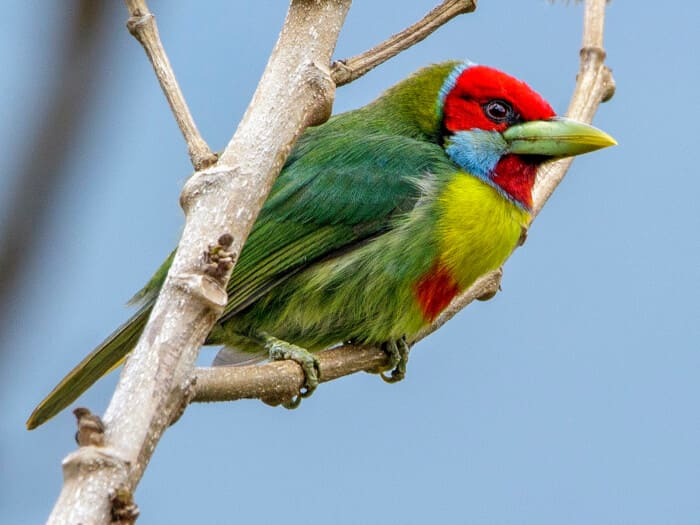 Image source: Ebird
Image source: Ebird
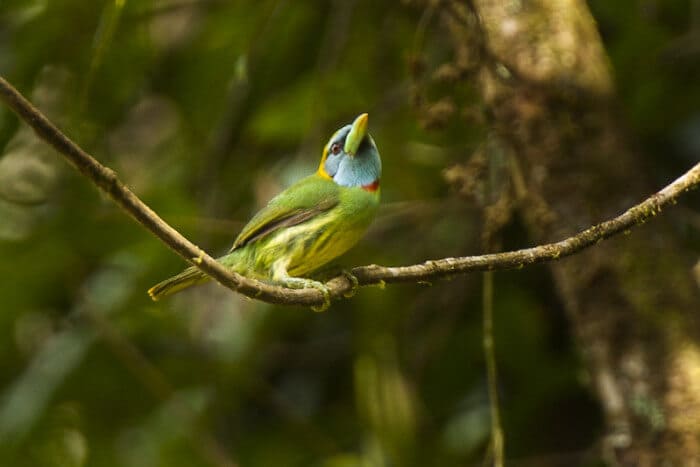 Image source: Francesco Verones
Image source: Francesco Verones
The bird’s colors are so vibrant that it resembles a cartoon character brought to life. The versicolored barbet always looks fierce and spirited, sporting a blue mustache-like stripe and a red feathered helmet.
This particular bird belongs to a bird family known as Capitonidae, which are called New World Barbets. The versicolored barbet has a strong beak, a characteristic shared by other barbets. Its scientific name is Eubucco Versicolor, and it should not be confused with similar-looking relatives. The versicolored barbet is further classified into three distinct subspecies.
Discover the incredible beauty of the Versicolored Barbet, a bird that bursts with vibrant colors!
Each subspecies of barbet has its unique appearance, but all male barbets share some distinctive features. They have a striking red face and crown, complemented by blue-green feathers above their eyes. Additionally, males exhibit a red half-moon marking on their lower breasts, which separates the lemony yellow chest from the feathered belly.
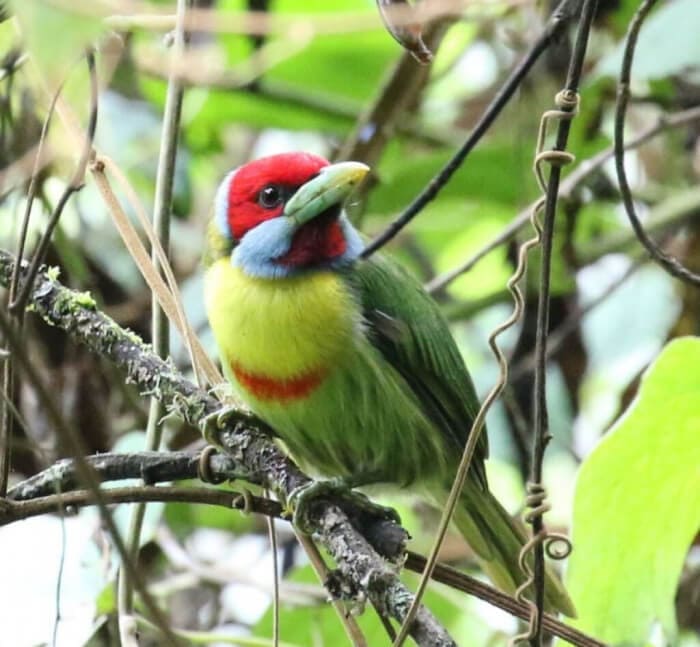 Image source: @satieairme
Image source: @satieairme
Female and male birds exhibit different color patterns.
Female birds display green to blue-green chest feathers, while males showcase vibrant yellow chest feathers. Furthermore, female birds possess a yellowish belly adorned with streaks of green plumage.
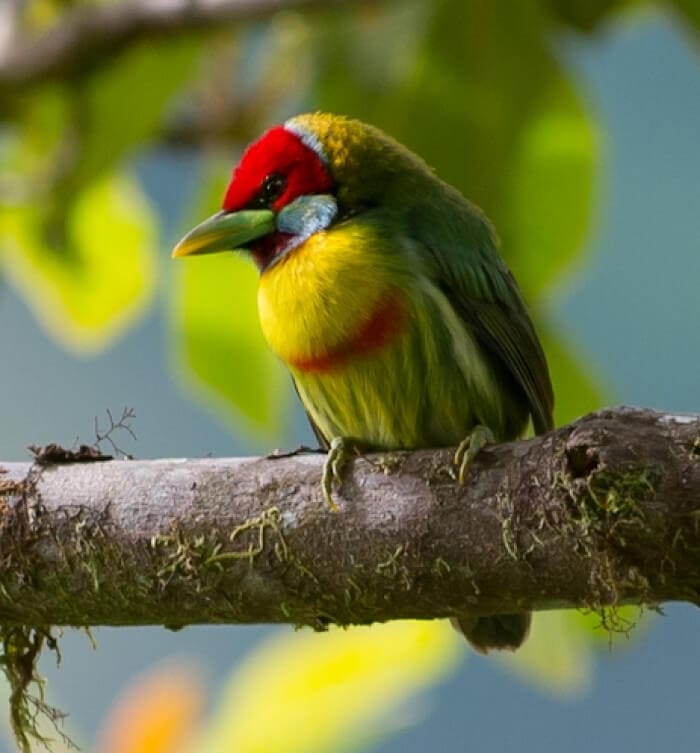 Image source: Joao Quental
Image source: Joao Quental
Although the versicolored barbet is native to Bolivia and Peru, it can now be found across the globe.
When fully grown, barbet subspecies typically measure around 6.3 inches in length. These birds are originally from South America and are not known for migrating. As a result, they can be found year-round in the jungles of Bolivia and Peru.
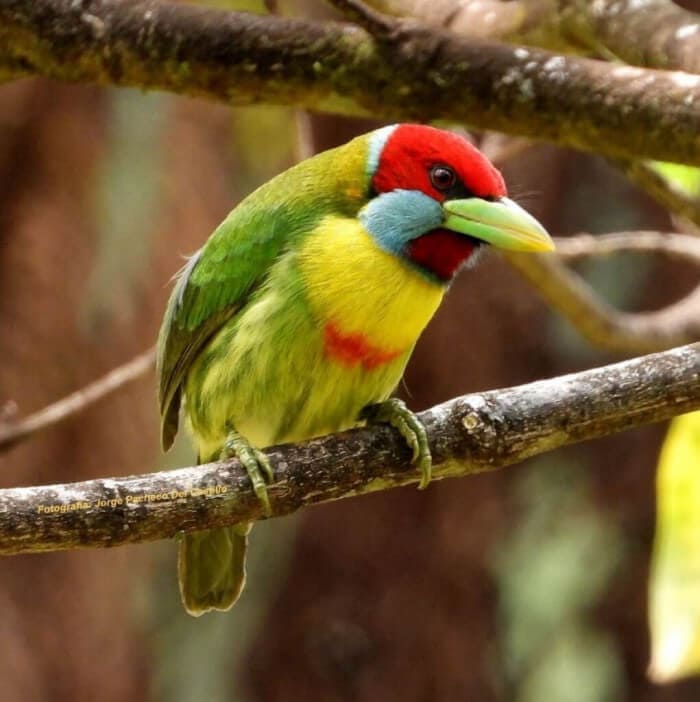 Image source: @jacamarclub
Image source: @jacamarclub
The versicolored barbet is commonly found in forests that are situated below mountainous regions.
The Versicolored barbet has three different types, and each of them resides in sub-mountainous regions where there are plenty of air plants and mosses. These birds also do well in older secondary forests and are usually found at elevations between 1,000 and 2,000 meters above sea level.
 Image source: @ericsonpinedo
Image source: @ericsonpinedo
There is still much that remains unknown about this particular species.
Studying this bird in its natural habitat is challenging because it is not accustomed to human presence. As a result, both the species and its subspecies have limited information regarding their breeding behaviors.
Barbets typically breed from July to December. Bird watchers have reported observing at least one nest with three eggs inside an existing tree hole.
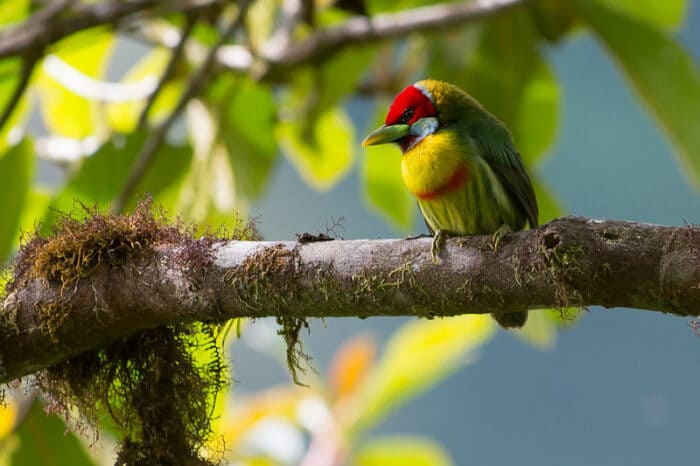 Image source: Joao Quental
Image source: Joao Quental
The beak of the versicolored barbet is surrounded by feathers that resemble a mustache.
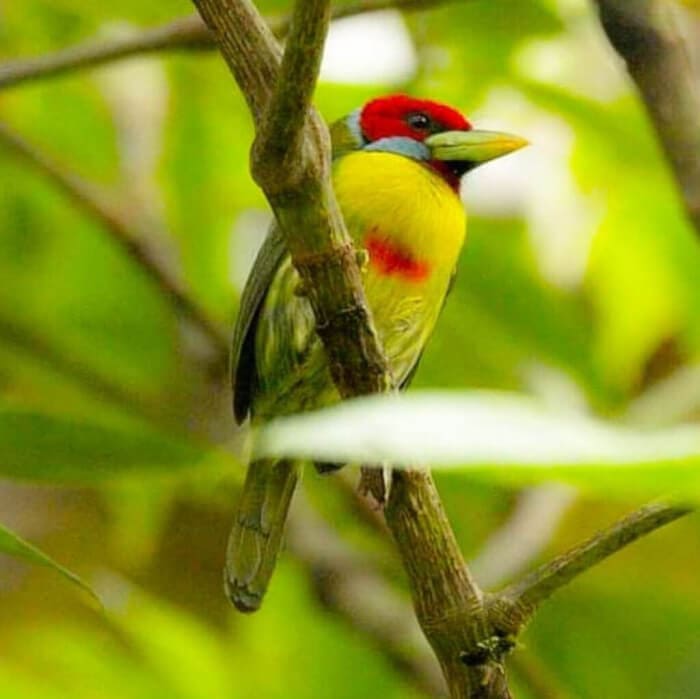 Image source: @colores_of_the_world
Image source: @colores_of_the_world
The female versicolored barbet has a blue chin and a green belly.
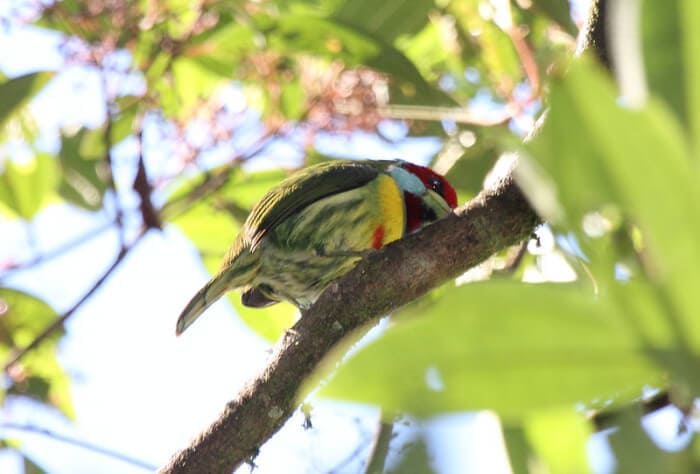 Image source: Dominic Sherony
Image source: Dominic Sherony
Watch the Video here:
Versicolored barbets are not commonly found and are considered rare species. Among the different subspecies, two are classified as being at a low conservation concern by the IUCN, while the Blue-chinned barbet is considered to be at a higher risk of becoming threatened.
ANIMALS
Amazing Video of Unseen Ocean Creatures in the Ningaloo Canyons

The Schmidt Ocean Institute recently explored the Ningaloo Canyons on the western coast of Australia using a robotic underwater vehicle called the ROV Sebastian. Check out the amazing video of what they discovered in the deep parts of the Indian Ocean.
More info: Youtube




ANIMALS
These Pics Are Art and the Artists Are Insects

Flying insects move so quickly that they are hard to follow, but new technology and some smart ideas have helped Spanish photographer Xavi Bou do just that. After spending 10 years focusing on birds in flight for his Ornithographies project, he turned his attention to insects.
For Entomographies, he uses high-speed video footage taken by Adrian Smith, an insect expert at North Carolina State University, to study and record how insects move. Bou then picks multiple frames and combines them into single images that show the fast movements of one or more insects through space and time.
With Smith’s help, Bou has captured the aerial tricks of wasps, the jumps of leafhoppers, and the fluttering of butterflies in amazing detail. He hopes that by doing this, he can make people more aware of the decline in important insect populations around the world.
1. Zebra longwing
This butterfly, which is common in many areas of the Americas, really fits its name. It can fly very high with just a few flaps of its large wings.
 Image source: nationalgeographic
Image source: nationalgeographic
2. Two-lined spittlebug
This insect, which comes from the eastern United States, is often seen as a pest because it likes to eat grass. Its springy back legs can make it jump into the air like a rocket.
 Image source: nationalgeographic
Image source: nationalgeographic
3. Yellow-collared scape moth
Unlike most moths, this North American species flies during the day. Its shiny blue-black wings sparkle in the sunlight.
 Image source: nationalgeographic
Image source: nationalgeographic
4. Ailanthus webworm moths
These tropical moths have spread farther north in the U.S. Because of their larval host, the invasive tree of heaven, they are now one of the most common backyard moths in the country.
 Image source: nationalgeographic
Image source: nationalgeographic
5. Common stonefly
Mostly found in eastern North America, this insect starts its life as an underwater nymph in forested streams or rivers. Then it leaves the water, sheds its skin, and becomes an adult with wings.
 Image source: nationalgeographic
Image source: nationalgeographic
6. Green lacewings
Eighty-seven species of this insect have been found in the U.S. and Canada. Since they eat a lot of unwanted plant pests like aphids and mites, they are often used to naturally control these pests.
 Image source: nationalgeographic
Image source: nationalgeographic
7. Grapevine beetle
This insect, fittingly named, eats the leaves and fruit of grapevines, both wild and farmed, but it doesn’t do much damage to the plants. As a type of scarab beetle, it often flies in a curved path.
 Image source: nationalgeographic
Image source: nationalgeographic
8. Oak treehopper and green treehopper
Treehoppers are known for their uniquely shaped pronotum, the part behind their head, which often looks like plant parts to hide from predators. They can jump well thanks to special muscles.
 Image source: nationalgeographic
Image source: nationalgeographic
9. Banded orange
This brightly colored butterfly can be found from Mexico to Brazil. Before mating season, male butterflies look for mineral salts, sometimes even drinking salty fluids from the skin, eyes, and nostrils of other animals.
 Image source: nationalgeographic
Image source: nationalgeographic
10. Sapho longwing
Longwings can live for 6 to 7 months, longer than most butterflies. This type, found from Mexico to Ecuador, has shiny blue wings, which is why it’s also called the Sapphire longwing.
 Image source: nationalgeographic
Image source: nationalgeographic
ANIMALS
Eagle and Fox in an Epic Midair Battle Over a Rabbit, Were Captured by a Photographer

Wildlife photography often depends on the perfect combination of good timing and the right place.
That’s exactly what happened when Kevin Ebi, an experienced wildlife photographer, captured an incredible battle between a bald eagle and a red fox, both competing for a rabbit meal.
In a detailed blog post, Ebi shares the fascinating series of events that unfolded while he was photographing foxes in San Juan Island National Historical Park, located in Washington state.
Ebi noticed a lively group of eight fox kits as they began their hunting lessons. Suddenly, they spotted a rabbit, and a thrilling chase ensued. Eventually, one of the foxes emerged as the winner, proudly carrying the rabbit across the field.
 Image source: Kevin Ebi
Image source: Kevin Ebi
Ebi shares what happened at that moment: “As I followed the fox with my camera, a sudden bald eagle cry caught my attention. It was swiftly approaching, clearly aiming for the rabbit. I quickly focused on the fox, anticipating a quick turnover of events.”
To Ebi’s astonishment, instead of a quick surrender, the situation turned into a intense fight in the air.
The eagle used its power to lift the fox and rabbit high up in the sky. Even while airborne, the fox attempted to break free by swinging back and forth.
 Image source: Kevin Ebi
Image source: Kevin Ebi
 Image source: Kevin Ebi
Image source: Kevin Ebi
 Image source: Kevin Ebi
Image source: Kevin Ebi
In the end, the eagle moved the rabbit to its other claw, causing the fox to let go. The intense battle came to an end in less than 10 seconds.
 Image source: Kevin Ebi
Image source: Kevin Ebi
For those worried about the fox’s well-being after the fight, Ebi reassures that it was not injured. The fox swiftly bounced back from the encounter and resumed its playful behavior with the other young foxes, showing no visible wounds from the aerial clash.
 Image source: Kevin Ebi
Image source: Kevin Ebi
 Image source: Kevin Ebi
Image source: Kevin Ebi
 Image source: Kevin Ebi
Image source: Kevin Ebi
 Image source: Kevin Ebi
Image source: Kevin Ebi
-

 GARDEN10 tháng ago
GARDEN10 tháng ago4 Easiest Ways to Get Free Plants
-

 ANIMALS10 tháng ago
ANIMALS10 tháng agoBritish Angler Caught Huge 67-Pound Goldfish in the World
-

 FUNNY10 tháng ago
FUNNY10 tháng ago30 Funny and Perplexing Photos That Make You Laugh All Day
-

 GARDEN9 tháng ago
GARDEN9 tháng ago30 Shimmering Side Yard Landscape Ideas
-

 FUNNY10 tháng ago
FUNNY10 tháng ago30 Weirdest Things That People Came Across On The Subway
-
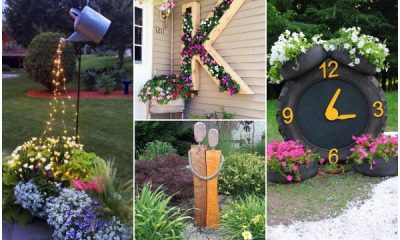
 DIY & CRAFT10 tháng ago
DIY & CRAFT10 tháng ago19 Easy and Creative DIY Ideas to Enhance Front Yard
-

 ANIMALS10 tháng ago
ANIMALS10 tháng agoKindhearted Driver Rescues Skinny Dog Hiding Near Highway Thanks to His Eagle Eye
-

 FUNNY10 tháng ago
FUNNY10 tháng ago22 Design Fails That Will Make You Laugh Out Loud





